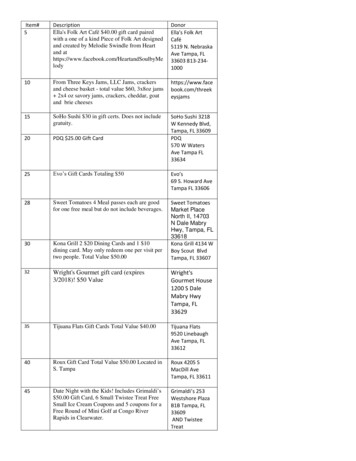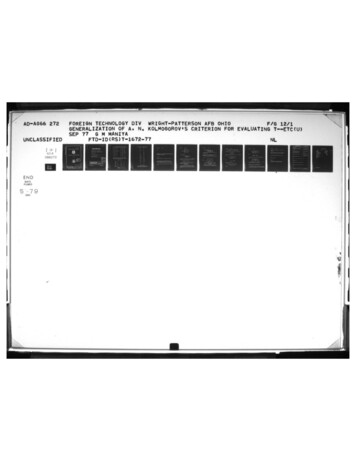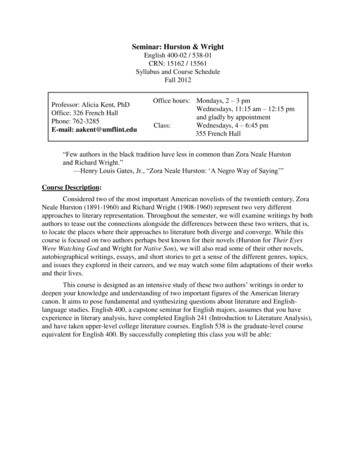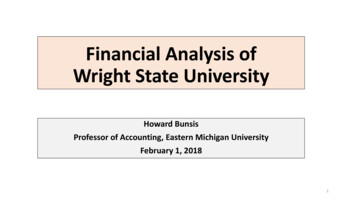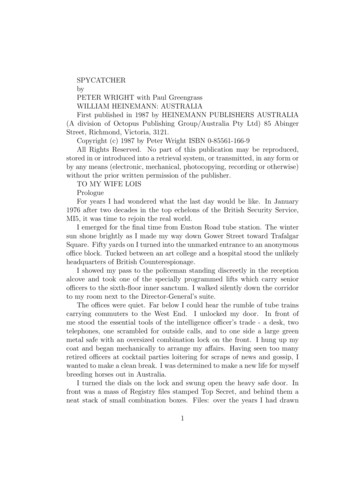
Transcription
SPYCATCHERbyPETER WRIGHT with Paul GreengrassWILLIAM HEINEMANN: AUSTRALIAFirst published in 1987 by HEINEMANN PUBLISHERS AUSTRALIA(A division of Octopus Publishing Group/Australia Pty Ltd) 85 AbingerStreet, Richmond, Victoria, 3121.Copyright (c) 1987 by Peter Wright ISBN 0-85561-166-9All Rights Reserved. No part of this publication may be reproduced,stored in or introduced into a retrieval system, or transmitted, in any form orby any means (electronic, mechanical, photocopying, recording or otherwise)without the prior written permission of the publisher.TO MY WIFE LOISPrologueFor years I had wondered what the last day would be like. In January1976 after two decades in the top echelons of the British Security Service,MI5, it was time to rejoin the real world.I emerged for the final time from Euston Road tube station. The wintersun shone brightly as I made my way down Gower Street toward TrafalgarSquare. Fifty yards on I turned into the unmarked entrance to an anonymousoffice block. Tucked between an art college and a hospital stood the unlikelyheadquarters of British Counterespionage.I showed my pass to the policeman standing discreetly in the receptionalcove and took one of the specially programmed lifts which carry seniorofficers to the sixth-floor inner sanctum. I walked silently down the corridorto my room next to the Director-General’s suite.The offices were quiet. Far below I could hear the rumble of tube trainscarrying commuters to the West End. I unlocked my door. In front ofme stood the essential tools of the intelligence officer’s trade - a desk, twotelephones, one scrambled for outside calls, and to one side a large greenmetal safe with an oversized combination lock on the front. I hung up mycoat and began mechanically to arrange my affairs. Having seen too manyretired officers at cocktail parties loitering for scraps of news and gossip, Iwanted to make a clean break. I was determined to make a new life for myselfbreeding horses out in Australia.I turned the dials on the lock and swung open the heavy safe door. Infront was a mass of Registry files stamped Top Secret, and behind them aneat stack of small combination boxes. Files: over the years I had drawn1
thousands. Now these were the last Routine agent reports circulated routinely to me, the latest reports of the Computer Working Party, the latestanalyses of Provisional IRA strength. Files always need answers. I had noneto give. The Russian diplomat’s file had been sent to me by a younger officer.Did I recognize him? Not really. It was a double-agent case which had beenrunning off and on for years. Did I have any ideas? Not really. When youjoin the Service each case looks different. When you leave they all seem thesame. I carefully initialed off the files and arranged for my secretary to takethem to the Registry.After lunch I set to work on the combination boxes, pulling them outfrom the back of the safe one by one. The first contained technical detailsof microphones and radio receivers - remnants of my time in the 1950s asMI5’s first scientific officer. I arranged for the contents to be sent over tothe Technical Department. An hour later the head of the Department cameover to thank me. He was very much the modern government scientist: neat,cautious, and constantly in search of money.“They were just odd things I kept,” I said. “I don’t suppose you’ll havemuch use for them. It’s all satellites now, isn’t it?”“Oh no,” he replied. “I’ll enjoy reading them.” He looked a little embarrassed. He and I had never really got on. We came from different worlds.I was a glue, sticks, and rubber-band improviser from the war; he was adefense contractor. We shook hands and I went back to sorting out my safe.The remaining boxes held papers gathered after I joined the Counterespionage Department in 1964, when the search for spies in British Intelligencewas at its most intense. The handwritten notes and typed aides-memoirewere packed with the universal currency of spying - lists of suspects and details of accusations, betrayals, and verdicts. Here, in the endless paper chasewhich began so clearly but ended in mystery, lay the threads of my career.Eventually my secretary came in and handed me two blue books. “Yourdiaries,” she said, and together we shredded them into the burn bag besidemy desk until it was time for the final ritual.I walked along to the Establishments Office. The duty officer handed mea file containing a list of my current secret indoctrinations. I began to sign offthe small chits. Access to Signals Intelligence and Satellite Intelligence wentfirst. Then I worked through the mass of case indoctrinations I held. Theacquisition of secrets is such a personal thing; the loss of them is painfullybureaucratic. Each stroke of the pen shut the door a little farther. Withinhalf an hour the secret world which had sustained me for years was closed2
off forever.Toward dark I took a taxi over to MI5’s old headquarters at LeconfieldHouse in Mayfair. The organization was in the process of moving to newoffices at the top of Curzon Street, but the staff bar, the Pig and Eye Club,where my farewell party was due to be held, still remained in LeconfieldHouse.I went into the old building. Here, in the teak-inlaid corridors and corniced offices, Philby, Burgess, Maclean, and Blunt were hunted down. Andhere too we had fought MI5’s most secret war over suspicions of an undiscovered mole at the heart of the Service. Our suspect was the former DirectorGeneral of MI5, Sir Roger Hollis, but we had never been able to prove it.Hollis’s friends had bitterly resented the accusation and for ten long yearsboth sides had feuded like medieval theologians, driven by instinct, passion,and prejudice.One by one in the 1970s the protagonists had retired, until finally themove to new offices signaled the end of the war. But walking the corridors ofLeconfield House I could still feel the physical sense of treachery, of pursuit,and the scent of the kill.My party was a quiet affair. People said nice things. The DirectorGeneral, Sir Michael Hanley, made a pretty speech, and I received the customary cards with their handwritten farewell messages. Lord Clanmorris,the great MI5 agent runner, wrote that my departure was “a sad, sad, irreplaceable loss.” He meant to the office. But the real loss was mine.That night I slept in the flat on the top floor of the Gower Street offices,woken occasionally by the noise of trains arriving at Euston Station. Earlythe next morning I dressed, picked up my briefcase, empty for the first time,and walked down to the front door. I said goodbye to the policeman andstepped outside onto the street. My career was over. A sad, sad, irreplaceableloss.-1It all began in 1949, on the kind of spring day that reminds you of winter. The rain drummed against the tin roof of the prefabricated laboratoryat Great Baddow in Essex, where I was working as a Navy scientist attachedto the Marconi Company. An oscilloscope throbbed in front of me like aheadache. Scattered across the trestle table was a mass of scribbled calculations. It was not easy designing a radar system able to pick out a submarineperiscope from amid the endless rolling wave clutter; I had been trying foryears. The telephone rang. It was my father, Maurice Wright, the Marconi3
Engineer in Chief.“Freddie Brundrett wants to see us,” he said.That was nothing new. Brundrett had been Chief of the Royal NavalScientific Service and was now Chief Scientist of the Ministry of Defense; hehad been taking a personal interest of late in the progress of the project. Adecision was needed soon over whether to fund production of a prototypesystem. It would be expensive. Postwar defense research was an endless battle against financial attrition, and I prepared myself for another ill-temperedskirmish.I welcomed the chance of talking to Brundrett direct. He was an oldfamily friend; both my father and I had worked for him in Admiralty Researchduring the war. Perhaps, I thought, there might be the chance of a new job.The following day we drove down to London in a steady drizzle and parkedthe car close to Brundrett’s office in Storey’s Gate. Whitehall looked grayand tired; the colonnades and statues seemed ill suited to a rapidly changingworld. Clement Attlee was still promising “teeth and spectacles,” but thewinter had been hard and people grew restless under rationing. The euphoriaof victory in 1945 had long since given way to sullen resentment.We introduced ourselves to the neat secretary in Brundrett’s outer office.The annex hummed in that subdued Whitehall way. We were not the firstto arrive. I greeted a few familiar faces, scientists from the various Services’laboratories. It seemed a large turnout for a routine meeting, I thought. Twomen I had never met detached themselves from the huddle.“You must be the Wrights,” said the shorter of the two abruptly. He spokewith a clipped military accent. “My name is Colonel Malcolm Cummingfrom the War Office, and this is my colleague Hugh Winterborn.” Anotherstranger came over. “And this is John Henry, one of our friends from theForeign Office.” Cumming employed the curious code Whitehall uses todistinguish its secret servants. Whatever the meeting was about, I thought,it was unlikely to concern antisubmarine warfare, not with a contingent fromMI5 and MI6 present. Brundrett appeared at the door of his office andinvited us in.His office, like his reputation, was vast. Giant sash windows and highceilings completely dwarfed his desk. He showed us to the conference table,which had been carefully lined with ink blotters and decanters Brundrettwas a small, energetic man, one of that select band, along with Lindemann,Tizard, and Cockcroft, responsible for gearing Britain for the technical andscientific demands of fighting World War II. As Assistant Director of Scientific4
Research for the Admiralty, and later Deputy Director of the Royal NavalScientific Service, he had been largely responsible for recruiting scientistsinto government service during the war. He was not especially gifted as ascientist, but he understood the vital role scientists could play. His policy wasto promote youth wherever possible and because the Service chiefs trustedhim he was able to get the resources necessary to enable them to perform attheir best.As a weary and diminished Britain girded herself to fight a new war inthe late 1940s - the Cold War - Brundrett was the obvious choice to advise onhow best to galvanize the scientific community once again. He was appointedDeputy Scientific Adviser to the Minister of Defense and succeeded Sir JohnCockcroft as Scientific Adviser and Chairman of the Defense Research PolicyCommittee in 1954.“Gentlemen,” began Brundrett when we were seated. “It is quite clearto all of us, I think, that we are now in the midst of war and have been sinceevents in Berlin last year.”Brundrett made it clear that the Russian blockade of Berlin and the Western airlift which followed had made a profound impact on defense thinking.“This war is going to be fought with spies, not soldiers, at least in theshort term,” he went on, “and I have been discussing where we stand withSir Percy Sillitoe, the Director-General of the Security Service. To be frank,”he concluded, “the situation is not good.”Brundrett crisply described the problem. It had become virtually impossible to run agents successfully behind the Iron Curtain, and there was aserious lack of intelligence about the intentions of the Soviet Union and herallies. Technical and scientific initiatives were needed to fill the gap.“I have discussed the matter in outline with some of you here, ColonelCumming from the Security Service and Peter Dixon representing MI6, andI have formed this committee to assess the options and initiate work atonce. I have also suggested to Sir Percy that he obtain the services of ayoung scientist to help on the research side. I intend to submit the name ofPeter Wright, whom some of you may know. He is currently attached to theServices Electronics Research Laboratory and he will go over on a part-timebasis until we find out how much work needs doing.”Brundrett looked across at me. “You’ll do that for us, won’t you, Peter?”Before I could reply he turned to my father. “We’ll obviously need helpfrom Marconi, G. M., so I have co-opted you onto this committee as well.”(Father was always known in the Navy by the name that Marconi was known5
by in the old days. )It was typical Brundrett, issuing invitations as if they were orders andbending the Whitehall machine thoroughly out of shape to get his way.For the rest of the afternoon we discussed ideas. The MI5 and MI6 contingents were conspicuously silent and I assumed it was the natural reticenceof the secret servant in the presence of outsiders. Each scientist gave anextempore synopsis of any research in his laboratory which might possiblyhave an intelligence application. Obviously a full-scale technical review ofintelligence services requirements would take time, but it was clear that theyurgently needed new techniques of eavesdropping which did not require entryto premises. Soviet security was so tight that the possibility of gaining entry,other than through party walls or when an embassy was being rebuilt, wasremote. By teatime we had twenty suggestions of possible areas of fruitfulresearch.Brundrett instructed me to draw up a paper assessing them, and themeeting broke up.As I was leaving, a man from the Post Office Technical Department, JohnTaylor, who had talked at some length during the meeting about post officework on listening devices, introduced himself. “We’ll be working together onthis,” he said, as we exchanged telephone numbers. “I’ll be in touch nextweek.”On the drive back to Great Baddow, Father and I discussed the meetingexcitedly. It had been so gloriously unpredictable, in the way that Whitehalloften was during the war and had so seldom been since. I was thrilled at theopportunity to escape from antisubmarine work; he because it continued thethread of secret intelligence which had run through the family for four anda half decades.-2My father joined the Marconi Company from university in 1912, andbegan work as an engineer on an improved method of detecting radio signals.Together with Captain H. J. Round, he succeeded in developing a vacuumreceiver which made the interception of long-range communications possiblefor the first time.Two days before World War I began, he was working with these receiversin the old Marconi Laboratory at Hall Street, Chelmsford, when he realizedhe was picking up German naval signals. He took the first batch to theMarconi works manager, Andrew Gray, who was a personal friend of CaptainReggie Hall, the head of the Naval Intelligence Department.6
Hall was the dominant figure in British Intelligence during World War Iand was responsible for attacking German ciphers from the famous Admiralty Room 40. He arranged for my father to travel up to Liverpool StreetStation on the footplate of a specially chartered locomotive. After studyingthe material he insisted Marconi release my father to build intercept anddirection-finding stations for the Navy.The central problem facing Naval Intelligence at the outbreak of WorldWar I was how to detect the German High Seas Fleet putting to sea in timeto enable the British Fleet, based at Scapa Flow, to intercept them. NavalIntelligence knew that when the German Fleet was quiescent she lay at theeastern end of the Kiel Canal. Hall believed it might be possible to detectthe German Commander-in-Chief’s wireless communications on board hisflagship as they passed through the Kiel Canal into the North Sea.My father set to work to design sufficiently sensitive equipment and eventually developed “aperiodic” direction-finding. This enabled the bearing ofthe wanted signal to be accurately identified among the mass of other interfering signals. It took several years to become operational but eventuallybecame an important weapon in the war against the U boats. Even todayall direction-finding equipment is “aperiodic.”In 1915, before the system was fully operational, my father suggested toHall that the best solution was to locate a direction finder in Christiania(now Oslo). Norway at this time was neutral, but the British Embassy couldnot be used for fear of alerting the Germans, so Hall asked my father ifhe was prepared to go and run the station clandestinely for MI6. Withindays he was on his way to Norway, posing as a commercial traveler tradingin agricultural medicines. He set up in a small hotel in a side street inChristiania and rented an attic room high enough to rig direction-findingwireless without being conspicuous.The MI6 station in the Embassy supplied him with communications andspare parts, but it was dangerous work. His radio equipment was bound togive him away eventually. He was not part of the diplomatic staff and wouldbe denied if discovered. At best he faced internment for the rest of the war,at worst he risked the attentions of German Intelligence.The operation ran successfully for six months, giving the Navy invaluableearly warning of German Fleet intentions. Then one morning he came downto breakfast at his usual table. He looked casually across the street to see anew poster being pasted onto the wall opposite. It was his photograph withan offer of a reward for information leading to his arrest.7
He had worked out his escape route with MI6 before the operation began.He quickly finished his breakfast, returned to his room, carefully packed hiswireless equipment in its case and pushed it under the bed. He gathered uphis travel documents, passport, and Naval identity card, leaving a substantialquantity of cash in the hope that it might encourage the hotelier to forgetabout him.Rather than taking the road toward the Swedish coast which the Norwegian authorities would assume to be his most likely escape route, he setoff to the southwest. Ten miles down the coast he sat down on a rock bythe roadside. Sometime later, a British Naval lieutenant walked up to himand asked him who he was. Father identified himself and he was taken to alaunch and ferried out to a waiting British destroyer.Years later, when I was coming up for retirement, I tried to find the detailsof this operation in the MI6 files. I arranged with Sir Maurice Oldfield, thethen Chief of MI6, to spend the day in their Registry looking for the papers.But I could find nothing; the MI6 weeders had routinely destroyed all therecords years before.I was born in 1916 at my grandmother’s house in Chesterfield, where mymother had gone to stay while my father was in Norway for MI6. There was aZeppelin raid on nearby Sheffield that night, and I arrived very prematurely.There were no hospital beds available because of the pressure of the war, butmy mother kept me alive with an improvised incubator of glass chemical jarsand hot-water bottles.After World War I my father rejoined the Marconi Company. He becamea protege of Marconi himself and was made Head of Research. We movedto a large house by the sea near Frinton. But this lasted only a few months,when we moved to a house on the outskirts of Chelmsford. The house oftenresembled a disused wireless factory. Radios in various states of disrepair andtin boxes filled with circuitry were hidden in every corner. My father was anintense, emotional, rather quick-tempered man - more of an artist than anengineer. As early as I can remember he used to take me out into the gardenor onto the open fields above the Essex beaches to teach me the mysteriesof wireless. He spent hours explaining valves and crystals and showed mehow to delicately turn the dials of a set so that the random static suddenlybecame a clear signal. He taught me how to make my own experiments and Ican still remember his pride when I demonstrated my crude skills to visitingguests like Sir Arthur Eddington and J. J. Thomson.MI6 had close connec
My party was a quiet a air. People said nice things. The Director-General, Sir Michael Hanley, made a pretty speech, and I received the cus-tomary cards with their handwritten farewell messages. Lord Clanmorris, the great MI5 agent runner, wrote that my departure was \a sad, sad, irre-placeab





